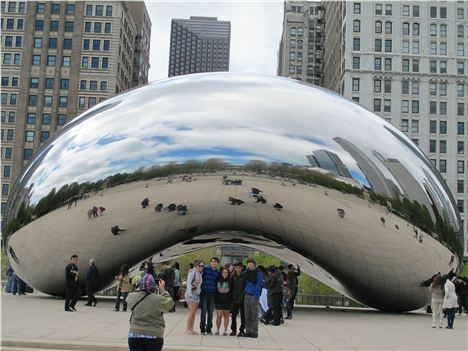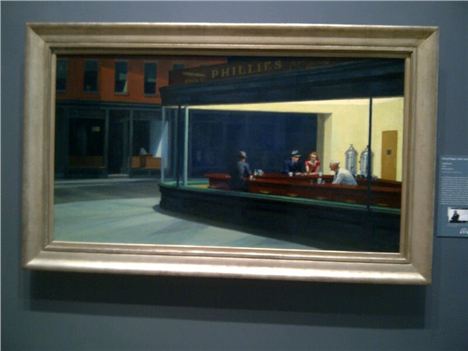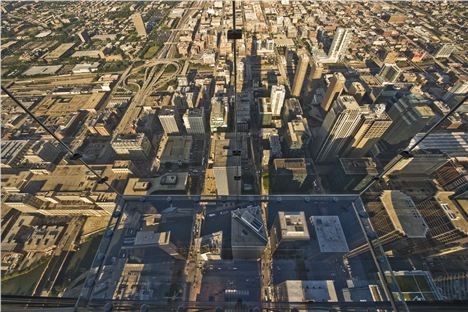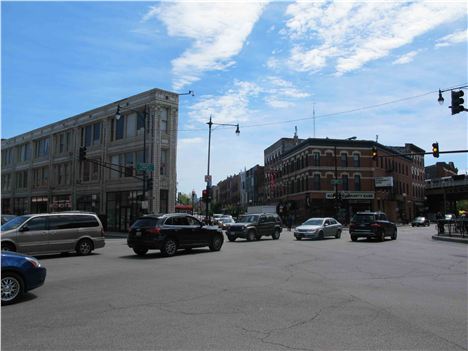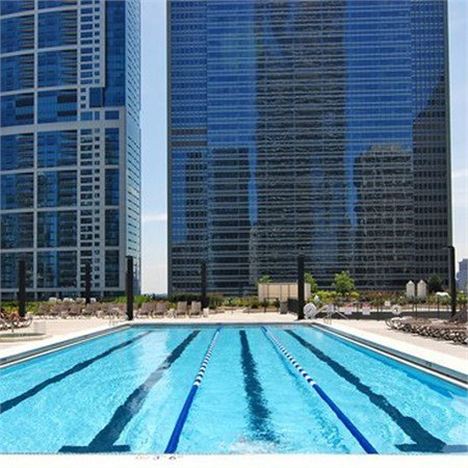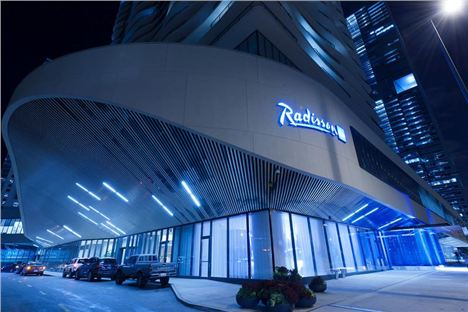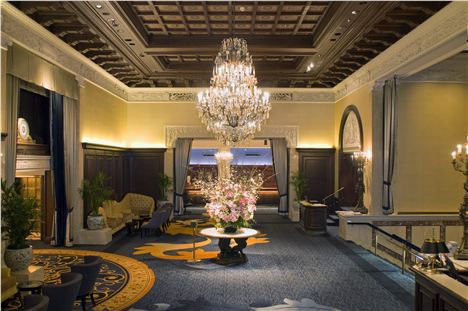WHAT would be scarier? Building your own quirky house, designed like no other, at the edge of hundreds of miles of empty rolling prairie? Or staring down 1,353 ft with apparently nothing between you and the ground?
From the great Frank Lloyd Wright pioneering his house designs on the raw edge of Oak Park 100 years ago to today’s skyscraper thrill-seeking on the Willis Tower’s Skydeck, Chicago has built – literally – a reputation as an architectural ground-breaker.
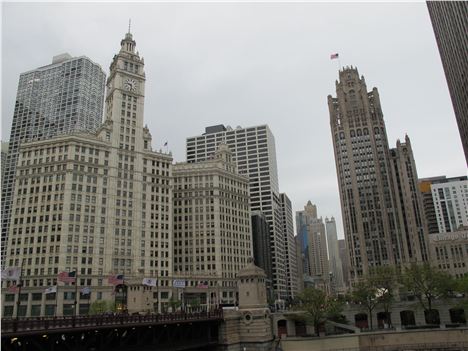 Wrigley Building And Tribune Tower
Wrigley Building And Tribune Tower
 Architecture Boat TourThat’s why on a grizzly, cold April day I’m boarding “Chicago’s First Lady” for a Chicago Architecture Foundation boat trip down the Chicago River... and briefly out into Lake Michigan for a full view of the city’s jaw-dropping skyline.
Architecture Boat TourThat’s why on a grizzly, cold April day I’m boarding “Chicago’s First Lady” for a Chicago Architecture Foundation boat trip down the Chicago River... and briefly out into Lake Michigan for a full view of the city’s jaw-dropping skyline.
Our docent (volunteer guide) addresses the few of us brave enough to share the open top deck with her. Most punters huddle below decks away from the drizzle. The faint-hearts avoid the hypothermia risk but miss some of the visceral excitement of 90 neck-craning minutes.
We’re offered a whirl of information about the devastating Great Fire of 1871, the amazing recovery that created a city of grid patterns and skyscrapers based upon iron and steel skeletons that set a blueprint for the world; the flourishing of Art Deco; and Bauhaus guru Mies Van der Rohe fleeing Germany to set up the Chicago School of Architecture, ushering in a world of austere minimalism. The architectural evidence looms large round every corner.
This tour is deservedly acclaimed, but I’d recommend a more hands-on initial introduction to the city. The Segway got a bad press when the millionaire creator of this two-wheeled motorised scooter plunged to his death on one a couple of years ago. They are banned on British roads, I believe. Undaunted (and not twigging that at the end of our park-based experience we would manoeuvre along busy Michigan Avenue!) I booked an Absolutely Segway Tour.
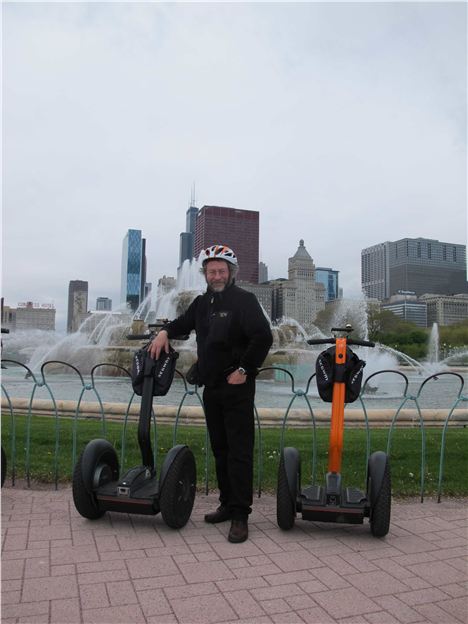 The Author With His Segway – glad of a breather
The Author With His Segway – glad of a breather
Unable even to ride a bike, I’m not a natural manipulator of a battery-driven, self-balancing personal transporter, but my Segway had a cap keeping it to six miles an hour, so I was comparatively jitter-free as we scooted through the large green lakeside spaces of Grant Park. It helped we stopped regularly to get our guide’s informed lowdown on the city spread out in front of us.
History is thick on the ground. Grant Park’s softball court was the scene of Barack Obama’s presidential victory speech in 2008; more notoriously, back in 1968 the park was a violent battleground during the Democratic Convention when Mayor Daley turned troops and National Guardsmen on anti-Vietnam war protesters. Tear gas blew back into the Hilton Hotel, choking presidential nominee Hubert Humphrey.
Today the Park is a serene escape from the urban intensity of the city centre. It contains or fringes onto the Art Institute of Chicago, Shedd Aquarium, Adler Planetarium and Field Museum (all with discounted entry via the Chicago City Pass – see Factfile) and Soldier Field, home of the Chicago Bears.
Latest addition is the Millennium Park, home of outdoor concerts and Anish Kapoor's public sculpture, Cloud Gate. Inspired by liquid mercury, it is nicknamed “The Bean” because of its shape and is made up of 168 stainless steel plates welded seamlessly together to warp reflections and provide mind-blowing photo-opportunities.
Chicago is blessed with 26 miles of Lake frontage much of it walkable, which I did (in part) on a sunny Sunday morning while awaiting the opening of the Art Institute, one of the world’s great collections. You could spend days exploring and not exhausting its riches. I didn’t have that luxury and found it a baffling complex to negotiate.
Still, after much scurrying, I got the 20th century American art annexe to myself. So I said howdy to the old folks in the iconic American Gothic, that much-parodied 1930 masterpiece by Grant Wood, then engulfed myself in the enigmatic loneliness of Edward Hopper’s Nighthawks. A new discovery was the rawly camp, dense canvasses of an artist new to me, Chicago’s Ivan Albright (check out his Dorian Gray). A swift homage, too, to the gallery’s many Manets, Monets and Georges Seurat’s imposing, definitively pointilliste La Grande Jatte and I was sated.
The nearby Chicago Cultural Center is a more low-key introduction to the city’s civilised core. Built in 1897, it is essentially a meeting place of like-minds, offering a host of free events and exhibitions in an ornate setting. Every city should have one.
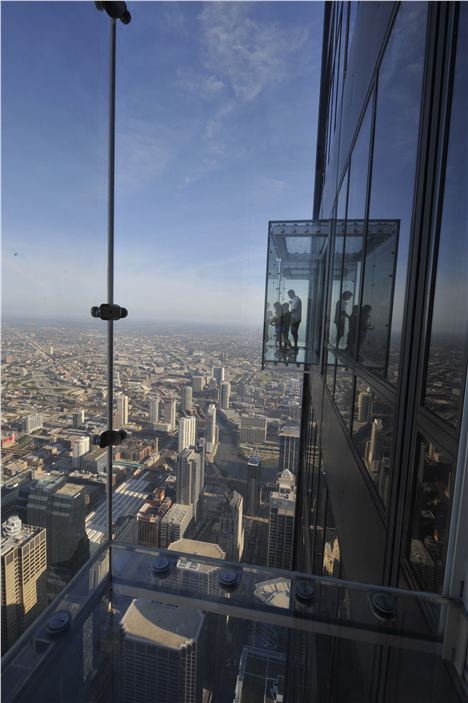 Skydeck, jutting out over the high-rise city
Skydeck, jutting out over the high-rise city
Only a few cities could run to a Skydeck. The Willis, formerly the Sears, Tower, has been overhauled a couple of times in the world’s tallest building stakes and won’t even be North America’s highest when New York’s One World Trade Center is completed in 2013. Still, the Willis boasts an incredible panorama, enhanced as a tourist attraction by the Skydeck Ledge, a series of glass bays that extend from the building’s 103rd floor.
Reaching out more than four feet from the west side, they offer unobstructed views of Chicago – including 1,353 feet straight down – and for 50 miles across four States.
More than one million annual visitors is testament to its appeal. It takes quite a time to filter up to the attraction but there are lots of interactive exhibit spaces on the way up, which are a splendid evocation of Chicago – its sports, architecture, pop culture, history, food, music and people. In contrast, a rival attraction the 100-storey John Hancock Observatory is a mite drab, apart from hosting a handy cocktail cafe at the summit.
Close up is sometimes best. The Loop, the old-time commercial quarter, hosts the start of Route 66 and offers echoes of the days of Al Capone, the mob and speakeasies. A splendid way to view is to hop on the CTA elevated railway and do the circuit. With the benefit of a $14 3-day unlimited rail pass, I stayed on the Green Line west to Oak Park.
It’s a half hour journey, the pilgrimage to the stamping ground of one of America’s and the world’s great architects. It’s out in the leafy suburbs, here at Oak Park or south in the university district (Robie House) that you find examples of Frank Lloyd Wright’s early handiwork.
 Frank Lloyd Wright House in Oak Park
Frank Lloyd Wright House in Oak Park
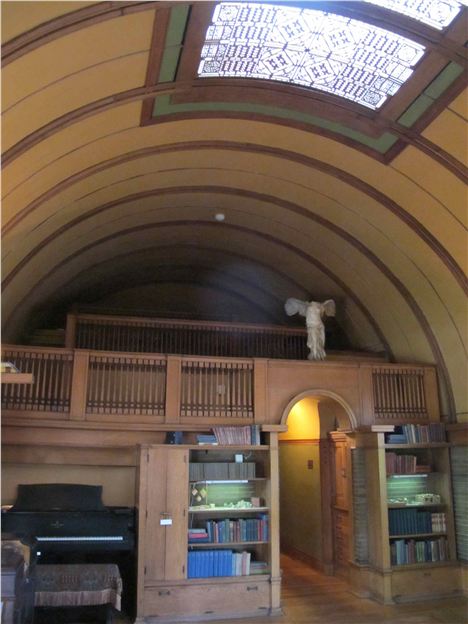 Frank Lloyd Wright House book room
Frank Lloyd Wright House book room
I aimed to visit his own home, a museum/shrine to a great if difficult creative genius. After dashing 15 minutes from the CTA station, I got the last ticket left on the last guided tour of the day, so my recommendation would be: book in advance. It’s well worth it – haunted by his presence.
Ernest Hemingway was raised in the same district, which in the early 20th century was definitely being carved out of the rough prairie. This frontiersman feel is evident in the house on Chicago Avenue where Wright, born in 1867, established his practice and raised six children before running off to Europe with a neighbour’s feminist wife in 1909.
Nothing was ever quite the same again in domestic architecture after Wright. Out of this so-called Prairie style arose a whole gospel of organic urban planning. All his Oak Park houses, built for the aspiring Chicago middle class reflect this – Japanese-influenced, open-plan inside, extended low buildings with shallow, sloping roofs, suppressed chimneys, and terraces and overhangs all using unfinished materials.
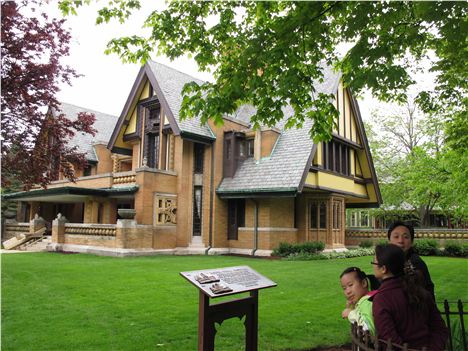 Frank Lloyd Wright domestic architecture in Oak Park
Frank Lloyd Wright domestic architecture in Oak Park
Today Oak Park is leafy and affluent, full of churches, all more orthodox than Lloyd Wright’s local contribution, the Unity Temple of 1908. The avenues just feel a little Stepford Wives, though. Much jollier is Wicker Park, where I went on a foodie guided tour (see Neil Sowerby’s Edible Chicago).
By the end of the 19th century it was the suburb of choice for wealthy German Scandinavian immigrants – exemplified by the heritage of desirable detached houses around the park created. The Poles arrived next in their thousands. In the park itself there’s a memorial to the great Polish pianist and premier Jan Padereweski, who briefly ran a government in exile here during World War One.
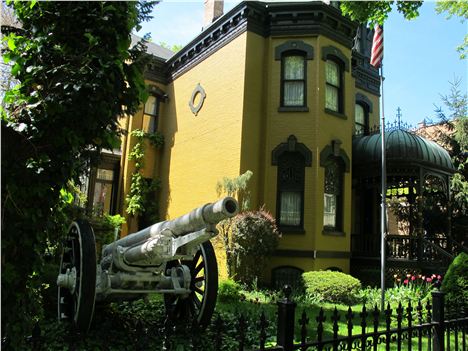 House boasts a historic cannon in Wicker Park
House boasts a historic cannon in Wicker Park
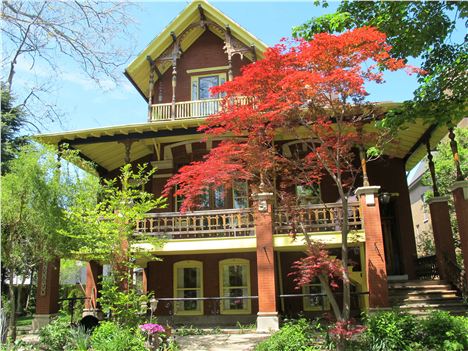 Wicker Park mansion with trees in bloom
Wicker Park mansion with trees in bloom
From the Eighties, artists were attracted to Wicker’s affordable loft spaces and urban feel. Nowadays it’s much gentrified but with appealing scruffy edges and a rotating quota of hip hang-outs, record and book shops.
During my Chicago visit I stayed in two terrific if contrasting hotels. Both I recommend highly. The spanking new Radisson Blu Aqua occupies the first 18 floors of Jeanne Gang’s undulating 80-storey Aqua Tower – the highest building in the world designed by a woman.
It’s close to the Millennium Park and the Lakefront but, unusually for the city, boasts a sizeable outdoor swimming pool (and a running trail) on a vast green roof and recreation deck. Inside there are 334 fashion-inspired rooms and suites, each with a choice of distinct styles – and loads of posh hi-tech extras.
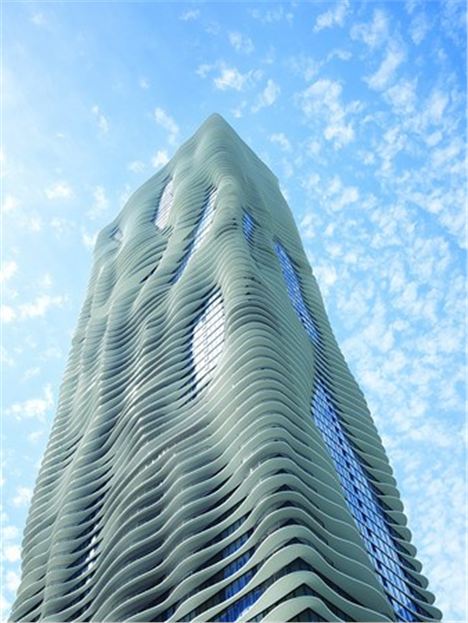 Radisson Blu Aqua is on 18 floors of the Aqua Tower
Radisson Blu Aqua is on 18 floors of the Aqua Tower
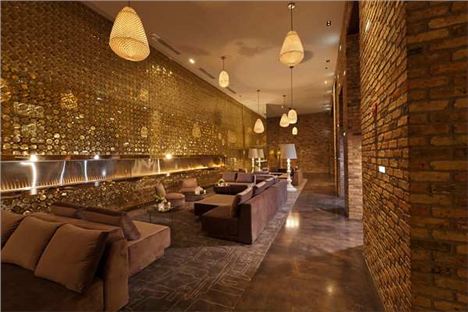 Radisson ground floor lounge area
Radisson ground floor lounge area
The “posh extras” at The Drake start with its flamboyantly decorated Twenties vintage Public Rooms, such as the Palm Court, perfect for afternoon tea, and the Gold Coast Ballroom. The hotel cost £10 million to build back in 1920. Current owners Hilton have refurbished cannily across the 535 rooms and 74 suites. I particularly liked the 11th Floor Private Executive Lounge with its spectacular views of the “Gold Coast” lakefront and an often choppy Lake Michigan.
The clincher for The Drake is its history. From Hollywood stars to royalty, from Winston Churchill to Barack Obama, the Drake has seen it all. Prince Diana, cut adrift from the Royal Family, stayed several nights in the Suite that now bears her name, inviting strangers to dine with her for their company. Fellow icon Marilyn Monroe and husband Joe di Maggio carved their initials (still visible) in the bar of the hotel’s Cape Cod restaurant.
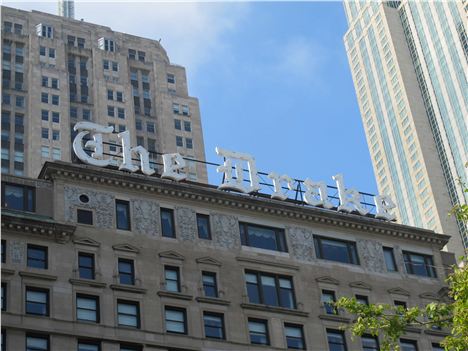 The Drake Sign - iconic for Chicago
The Drake Sign - iconic for Chicago
 Gold Coast Ballroom in the Drake Hotel
Gold Coast Ballroom in the Drake Hotel
Oh, and there is a hotel ghost, the Woman in Red. I won’t tell you which floor she walks. That would spoil things. Her tragedy happened on The Drake’s opening night. According to legend a wealthy investor and his fiancé attended the opening gala in the Gold Coast Room. When the man disappeared for a while, his bride-to-be went looking for him. She found him, in the arms of another woman, in the Palm Court. Devastated, the jilted woman in the crimson silk gown climbed to the roof and jumped to her death.
Just 11 storeys to fall. Today The Drake is dwarfed by the ever-expanding Chicago skyline, which can be seen for miles across the Great Prairies. It’s a truly amazing city where the history is as monumental as the buildings.
Fact file
Neil Sowerby’s tips on where to eat and drink in Chicago:http://www.planetconfidential.co.uk/Abroad/Neil-Sowerbys-edible-Chicago
What to do:
Absolutely Segway Tour, 337 East Randolph Street (+1 312 552 5100, www.chicagosegways.com).
Skydeck Chicago – The Ledge at Willis Tower Skydeck Chicago. Open daily April-Sept 9 am.– 10 pm and Oct-Mar 10 am-8 pm. For further details and to book visit www.theskydeck.com or call 1.877.SKY.DECK.
Art Institute Chicago. Mon-Wed 10.30am-5pm; Thurs 10.30am-8pm; Fri-Sun 10.30am-5pm. Roy Lichtenstein exhibition from May 6 2012. www.artinstituteofchicago.org.
Chicago Architecture Foundation Boat Tours, First Lady Cruise Dock, at Michigan Avenue/Wacker Drive. For full schedule visit www.architecture.org/tours. +1 312 922 8687. $35 dollars in advance, $38 on day.
Frank Lloyd Wright House, 951 Chicago Avenue, Oak Park, (+1 312 994 4000). Open daily 10am-5pm, tours 11am-4pm, booking recommended. For more information and ticket details visit www.gowright.org.
Staying there:
The Drake Hotel, 140 East Walton Place. (+1-312-787-2200 www.thedrakehotel.com).
Rooms from $159 a night (special offer).
https://secure3.hilton.com/en_US/hi/reservation/book.htm?execution=e1s1
Radisson Blu, 221 North Columbus Drive Chicago, (+1 (312) 565-5BLU www.radissonblu.com/aquahotel-chicago).
Rooms start at $199 in the summer months, and $250 in the autumn/winter.
Getting there:
From Manchester, United Airlines offers daily non-stop service to its hubs in New York (Newark Liberty International) and Washington D.C. (Washington Dulles International). From both hubs, United offers conveniently timed connections to its Chicago hub, Chicago O’Hare International Airport. Return fares to Chicago in United Economy start from £626 including taxes. For everyday low prices, visit www.united.com or call 0845 8 444 777.
Tourist help:
For further information about Chicago please visit www.choosechicago.com.
Chicago CityPass. easy to use booklet with 5 admission tickets to top attractions (two offering alternatives), saving 50 per cent on admission prices. Adult $84, child 3-11 $39. Good across nine days. Attractions include Shedd Aquarium, Adler Planetarium, Skydeck, John Hancock Observatory. Buy online, www.citypass.com, or at any attraction.
For CTA Unlimited Ride Cards, visit www.transitchicago.com/travel_information/fares/unlimitedridecards.aspx










